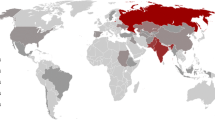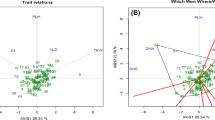Abstract
Triticale (X Triticosecale Wittm.) is a hybrid derived by crossing wheat (Triticum sp.) and rye (Secale sp.). Till date, only a limited number of simple sequence repeat (SSRs) markers have been used in triticale molecular analyses and there is a need to identify dedicated high-throughput molecular markers to better exploit this crop. The objective of this study was to develop and evaluate diversity arrays technology (DArT) markers in triticale. DArT marker technology offers a high level of multiplexing. Development of new markers from triticale accessions was combined with mining the large collection of previously developed markers in rye and wheat. Three genotyping arrays were used to analyze a collection of 144 triticale accessions. The polymorphism level ranged from 8.6 to 23.8% for wheat and rye DArT markers, respectively. Among the polymorphic markers, rye markers were the most abundant (3,109) followed by wheat (2,214) and triticale (719). The mean polymorphism information content values were 0.34 for rye DArT markers and 0.37 for those from triticale and wheat. High correlation was observed between similarity matrices derived from rye, triticale, wheat and combined marker sets, as well as for the cophenetic values matrices. Cluster analysis revealed genetic relationships among the accessions consistent with the agronomic and pedigree information available. The newly developed triticale DArT markers as well as those originated from rye and wheat provide high quality markers that can be used for diversity analyses and might be exploited in a range of molecular breeding and genomics applications in triticale.


Similar content being viewed by others
References
Akbari M, Wenzl P, Caig V, Carling J, Xia L, Yang S, Uszynski G, Mohler V, Lehmensiek A, Kuchel H, Hayden M, Howes N, Sharp P, Vaughan P, Rathmell B, Huttner E, Killian A (2006) Diversity arrays technology (DArT) for high-throughput profiling of the hexaploid wheat genome. Theor Appl Genet 113:1409–1420
Amiour N, Bouguennec A, Marcoz C, Sourdille P, Bourgoin M, Khelifi D, Branlard G (2002) Diversity of seven glutenin and secalin loci within triticale cultivars grown in Europe. Euphytica 123:295–305
Ammar K, Mergoum M, Rajaram S (2004) The history and evolution of triticale. In: Mergoum M, Gomez-Macpherson H (eds) Triticale improvement and production, 1st edn. FAO, Rome, pp 1–10
Barnett RD, Blount AR, Pfahler PL, Bruncker PL, Wesenberg DM, Johnson JW (2006) Environmental stability and heritability estimates for grain yield and test weight in triticale. J Appl Genet 47:207–213
Bolibok-Brągoszewska H, Heller-Uszyńska K, Wenzl P, Uszyński G, Kilian A, Rakoczy-Trojanowska M (2009) DArT markers for the rye genome-genetic diversity and mapping. BMC Genomics 10:578
Brown SM, Hopkins MS, Mitchell SE, Senior ML, Wang TY, Duncan RR, Gonzalez-Candelas F, Kresovich S (1996) Multiple methods for the identification of polymorphic simple sequence repeats (SSRs) in sorghum [Sorghum bicolor (L.) Moench]. Theor Appl Genet 93:190–198
Budak H, Baenzinger PS, Beecher BS, Graybosch RA, Campbell BT, Shipman MJ, Erayman M, Eskridge KM (2004) The effect of introgressions of wheat D-genome chromosomes into ‘Presto’ triticale. Euphytica 137:261–270
Cheung WY, Hubert N, Landry BS (1993) A simple and rapid DNA microextraction method for plant, animal and insect suitable for RAPD and other PCR analyses. PCR Method Appl 3:69–70
Crossa J, Burgueno J, Dreisigacker S, Vargas M, Herrera-Foessel SA, Lillemo M, Singh RP, Trethowan R, Warburton M, Franco J, Reynolds M, Crouch JH, Ortiz R (2007) Association analysis of historical bread wheat germplasm using additive genetic covariance of relatives and population structure. Genetics 177:1889–1913
Dice LR (1945) Measures of the amount of ecologic association between species. Ecology 26:297–302
Dirlewanger E, Cosson P, Tavaud M, Aranzana MJ, Poizat C, Zanetto A, Arus P, Laigret F (2002) Development of microsatellite markers in peach [Prunus persica (L.) Batsch] and their use in genetic diversity analysis in peach and sweet cherry (Prunus avium L.). Theor Appl Genet 105:127–138
Gustafson JP, Bennett MD (1976) Preferential selection for wheat-rye substitutions in 42-chromosome triticale. Crop Sci 16:688–693
Gustafson JP, Dille JE, Skovmand B (1989) Wheat substitutions in hexaploid triticale. Plant Breed 102:109–112
Hills MJ, Hall LM, Messenger DF, Graf RJ, Beres BL, Eudes F (2007) Evaluation of crossability between triticale (X Triticosecale Wittmack) and common wheat, durum wheat and rye. Environ Biosafety Res 6:249–257
Jaccoud D, Peng K, Feinstein D, Kilian A (2001) Diversity arrays: a solid state technology for sequence information independent genotyping. Nucleic Acids Res 29:E25
Kuleung C, Baenzinger PS, Dweikat I (2004) Transferability of SSR markers among wheat, rye, and triticale. Theor Appl Genet 108:1147–1150
Kuleung C, Baenzinger PS, Kachman SD, Dweikat I (2006) Evaluating the genetic diversity of triticale with wheat and rye SSR markers. Crop Sci 46:1692–1700
Leonova IN, Dobrovolskaya OB, Kaminskaya LN, Adonina IG, Koren LV, Khotyljova LV, Salina EA (2005) Molecular analysis of the triticale lines with different vrn gene systems using microsatellite markers and hybridization in situ. Russian J Genet 41:1014–1020
Lotti C, Salvi S, Pasqualone A, Tuberosa R, Blanco A (2000) Integration of AFLP markers into an RFLP-based map of durum wheat. Plant Breed 119:393–401
Lukaszewski AJ (1988) Chromosome constitution of hexaploid triticale lines in the recent international yield trials. Plant Breed 100:268–272
Lukaszewski AJ, Curtis C (1994) Transfer of the Glu-D1 gene from chromosome 1D to chromosome 1A in hexaploid triticale. Plant Breed 112:177–182
Ma XF, Gustafson JP (2008) Allopolyploidization-accommodated genomic sequence changes in triticale. Ann Bot 101:825–832
Malosetti M, van der Linden CG, Vosman B, van Eeuwijk FA (2007) A mixed model approach to association mapping using pedigree information with an illustration to resistance for Phytophthora infestas in potato. Genetics 175:879–889
Mantel N (1967) The detection of disease clustering and a generalized regression approach. Cancer Res 27:209–220
Mantovani P, Maccaferri M, Sanguineti MC, Tuberosa R, Catizone I, Wenzl P, Thomson B, Carling J, Huttner E, DeAmbrogio E, Kilian A (2008) An integrated DArT-SSR linkage map of durum wheat. Mol Breed 22:629–648
Nascimento A Jr, Baier AC, Teixeira MCC, Wiethölter S (2004) Triticale in Brazil. In: Mergoum M, Gomez-Macpherson H (eds) Triticale improvement and production, 1st edn. FAO, Rome, pp 93–98
Oettler G (2005) The fortune of a botanical curiosity—triticale: past, present and future. J Agric Sci 143:329–346
Ozkan H, Levy AA, Feldman M (2001) Allopolyploidy-induced rapid genome evolution in the wheat (Aegilops-Triticum) group. Plant Cell 13:1735–1747
Peleg Z, Saranga Y, Suprunova T, Ronin Y, Röder MS, Kilian A, Korol AB, Fahima T (2008) High-density genetic map of durum wheat × wild emmer wheat based on SSR and DArT markers. Theor Appl Genet 117:103–115
Pilch J (1989) Chromosomal R-D genome substitutions in spring triticale. Vortr. Pflanzenzücht 15-I:7–8
Röder MS, Korzun V, Wendehake K, Plaschke J, Tixier MH, Leroy P, Ganal MW (1998) A microsatellite map of wheat. Genetics 149:2007–2023
Rohlf FJ (1997) NTSYSpc, numerical taxonomy and multivariate analysis system, version 2.02e. Exeter Publishing, Setauket
Royo C, Soler C, Romagosa I (1995) Agronomical and morphological differentiation among winter and spring triticales. Plant Breed 114:413–416
Semagn K, Bjornstad A, Ndjiondjop MN (2006a) An overview of molecular marker methods for plants. African J Biotechnol 5:2540–2568
Semagn K, Bjornstad A, Skinnes H, Maroy AG, Tarkegne Y, William M (2006b) Distribution of DArT, AFLP, and SSR markers in a genetic linkage map of a doubled-haploid hexaploid wheat population. Genome 49:545–555
Soltis DE, Soltis P (1999) Polyploidy: recurrent formation and genome evolution. Trends Ecol Evol 14:348–352
Stodart BJ, Mackay MC, Raman H (2007) Assesment of molecular diversity in landraces of bread wheat (Triticum aestivum) held in an ex situ collection with Diversity Arrays Technology (DArT). Australian J Agr Res 58:1174–1182
Tams SH, Bauer E, Oettler G, Melchinger AE (2004) Genetic diversity in European winter triticale determined with SSR markers and coancestry coefficient. Theor Appl Genet 108:1385–1391
Tams SH, Melchinger AE, Bauer E (2005) Genetic similarity among European winter triticale elite germplasm assessed with AFLP and comparisons with SSR and pedigree data. Plant Breed 124:154–160
Tinker NA, Kilian A, Wight CP, Heller-Uszynska K, Wenzl P, Rines HW, Bjornstad A, Howarth CJ, Jannink JL, Anderson JM, Rossnagel BG, Stuthman DD, Sorrells ME, Jackson EW, Tuvesson S, Kolb FL, Olsson O, Federizzi LC, Carson ML, Ohm HH, Molnar SJ, Scoles GJ, Eckstein PE, Bonman JM, Ceplitis A, Langdon T (2009) New DArT markers for oat provide enhanced map coverage and global germplasm characterization. BMC Genomics 10:39
Wenzl P, Carling J, Kudrna D, Jaccoud D, Huttner E, Kleinhofs A, Kilian A (2004) Diversity arrays technology (DArT) for whole-genome profiling of barley. Proc Natl Acad Sci USA 101:9915–9920
Wenzl P, Li H, Carling J, Zhou M, Raman H, Paul E, Hearnden P, Maier C, Xia L, Caig V, Ovesna J, Cakir M, Poulsen D, Wang J, Raman R, Smith KP, Muehlbauer GJ, Chalmers KJ, Kleinhofs A, Huttner E, Kilian A (2006) A high-density consensus map of barley linking DArT markers to SSR, RFLP and STS loci and agricultural traits. BMC Genomics 7:206
Wittenberg AHJ, van der Lee T, Cayla C, Kilian A, Visser RGF, Schouten HJ (2005) Validation of the high-throughput marker technology DArT using the model plant Arabidopsis thaliana. Mol Genet Genomics 274:30–39
Xia L, Peng K, Yang S, Wenzl P, de Vicente C, Fregene M, Kilian A (2005) DArT for high-throughput genotyping of cassava (Manihot esculenta) and its wild relatives. Theor Appl Genet 110:1092–1098
Acknowledgments
This research was supported in part by the Alberta Agriculture and Food Department and Alberta Agriculture Research Institute. The Swedish SLF/FORMAS is acknowledged for financial support. Wheat markers identified in this study were developed with financial support from Grains Research and Development Corporation (GRDC) of Australia and several other smaller investors and research collaborators of Diversity Arrays Technology Pty Ltd. Rye markers were developed at Diversity Arrays Technology Pty Ltd with participation and financial support of Hanna Bolibok-Bragoszewska and Monika Rakoczy-Trojanowska from Warsaw Agricultural University, Poland. A number of Diversity Arrays Technology Pty Ltd staff contributed to various aspects of technical execution of the project, for which the authors are very grateful. All those listed in the M&M section as contributors of the DNA samples are sincerely thanked. Dr. Adam Lukaszewski, UC Riverside, USA, is also thanked for providing numerous other contributions throughout the project and critical reading of the manuscript.
Author information
Authors and Affiliations
Corresponding author
Additional information
Communicated by H. H. Geiger.
D. Salmon: Deceased.
Electronic supplementary material
Below is the link to the electronic supplementary material.
Rights and permissions
About this article
Cite this article
Badea, A., Eudes, F., Salmon, D. et al. Development and assessment of DArT markers in triticale. Theor Appl Genet 122, 1547–1560 (2011). https://doi.org/10.1007/s00122-011-1554-3
Received:
Accepted:
Published:
Issue Date:
DOI: https://doi.org/10.1007/s00122-011-1554-3




